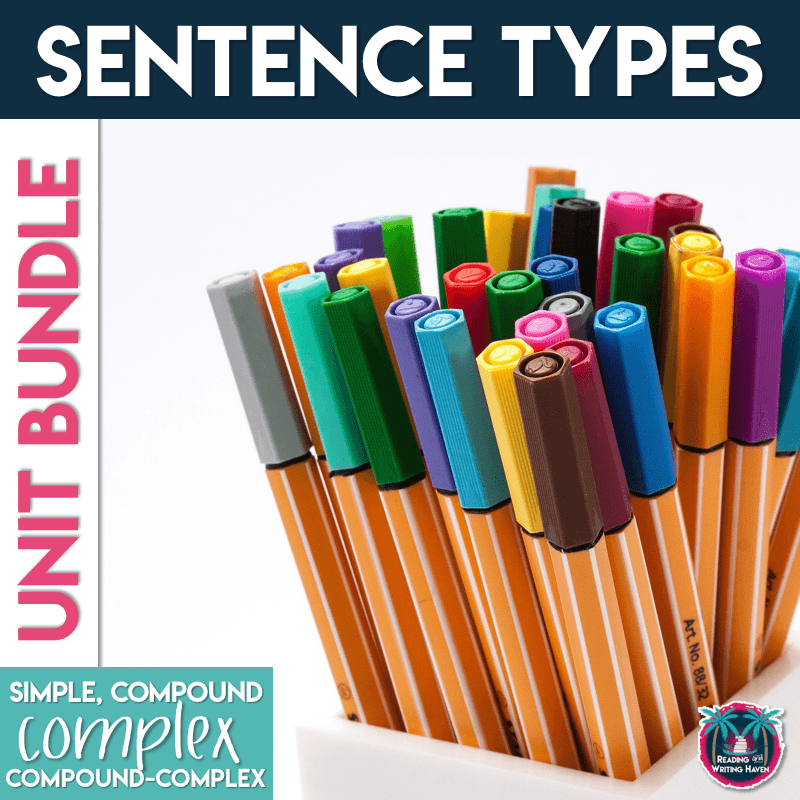Get Your Nerd On: How to Structure A Grammar Lesson
“Everyone is telling me to teach grammar, but no one has told me HOW yet! There’s so much information and so many ideas, and I’m just overwhelmed!” If you’ve ever felt those sentiments about grammar instruction, don’t lose heart. Teaching grammar isn’t easy, but it’s worthwhile. This post is for you.
Because grammar is slowly but surely making its way back into classrooms across America (at least in those places where it once made an exit), there’s no shortage of information floating around about best practices. In previous posts, I’ve written about how to make grammar interesting, how to sequence grammar instruction when designing your curriculum, and why we should teach it. But there’s something missing…how do you actually put all these ideas into action in the classroom? What should a grammar lesson look like?
Certainly, there are enough answers to that question to write a book on it, but in today’s post, I’m sharing how I teach grammar in my classroom. When I sit down in front of my lesson plan book, these are the things I think about…I’ll call it a “MENU” approach. For the purpose of example, I’ll be using commas in this post, but you can apply these same options to pretty much any grammar skill you are teaching.
Appetizer: Hook (Anticipatory Set)
You’ll get more investment from students if you can sneakily grab their interest in the concept before you actually utter the word “grammar.” Here are a few ideas for hooks you could consider using to capture students’ attention.
Real-Life Grammar Fails
Nothing is as convincing as a relevant story or example of how not understanding a certain grammar concept can lead to problems in real life. If we’re talking about commas, you could use this recent post about how the absence of the Oxford comma impacted a court’s ruling in Maine. Read about it here.
Music
If you want your students to feel engaged, play a song for them as they are walking in the room. Then, after the bell rings, tell them that you are playing it again, and ask them to pay special attention to the use of commas in the lyrics. I print the lyrics out so that students can highlight and annotate them as they listen. One I enjoy for comma lessons is Billy Joel’s “We Didn’t Start the Fire.” After students listen a second time, I briefly ask questions like:
- What comma patterns did you notice in these lyrics?
- What comma rules did the artist follow to a T?
- Which comma rules are broken? Why would the song writer have chosen to do this?
Riddles and Jokes
Everyone enjoys a riddle…so why not use them to make grammar more enticing? You can make up your own, or search for them online. I came across this cute brainteaser about commas after approximately 30 seconds of Googling. It doesn’t take long to make instruction fun! I would write the riddle, joke, or question on the board, and students will naturally be talking about it and thinking about the answer as they wait for the bell to ring.
Writing Prompt
Put an unrelated picture, cartoon, question, or prompt up on the board, and ask students to write about it for a few minutes…free writing style. Make sure it’s one that’s interesting so that students will actually want to write about it. Then, have them put aside their responses until after your lesson. Following your direct instruction, ask students to pull these responses back out and check them over for errors involving that particular skill. This technique helps students to see the authenticity, relevancy, and applicability of grammar in their own writing.
Memes and Pictures
Everyone is familiar with the “Let’s eat Grandma vs. Let’s eat, Grandma!” memes. As widely recognized as they are, students and teachers still chuckle when they see them. If you personally don’t have time to search for memes and pictures for each grammar lesson, have students do some research.
One time I gave my students an assignment to find memes related to grammar concepts we were studying in class, and they earned a point of extra credit for each unique source they uncovered. The students loved it, and so did I. It saved me time, but more importantly, they were doing the thinking. We then created a bulletin board arrangement using their findings.
After choosing an intriguing hook, you’re ready to move on to the next phase of the lesson.
Entree: Direct Instruction
When it comes to direct instruction, students need to hear and see the concept explained by the teacher before they are asked to work independently. It’s true that grammar instruction is most effective when taught in the context of reading and writing, but students need mini lessons, and it’s okay for those to be via direct instruction first. To make it engaging, I find a lot of value in chunking my direct instruction. What do I mean by that?
Presentation
You could use a presentation with built-in grammar exercises. I use this one for my comma rules lesson. I introduce a concept, show students examples, and then complete five to ten practice examples together before moving onto the next layer of the skill.
When we complete practice activities together, I have students do the thinking. What does that look like? Sometimes we use the smart board, and they underline sentence parts or they circle punctuation. Other times, we use small dry erase boards. Students write down their answers and hold up their boards. Another option is using think-pair-share and then having students share their answers with the group.
Printed Reference Notes
Just to switch things up, I don’t always use presentations. If I know students have learned about a concept before (like conjunctions, for example), I might just use printed reference sheets as mini . lessons to review the concept before practicing the skill. These note sheets should be short reminders that only take five or ten minutes time total. This example can be used for reviewing comma usage rules with older students.
Flipped Videos
I have experimented with flipped classroom approaches in my ELA class for several years. By far, the most effective use of flipping in an English class is for grammar purposes. Grammar is a concept that students really do need to take in at their own pace, and they need to see examples repeated. If you haven’t done so already, try recording a five to ten minute (no longer!) video of yourself teaching a grammar lesson, using examples and engaging illustrations. Assign it to be viewed outside of class, and hold students accountable by having them take notes. The next day, you can answer student questions and differentiate practice based on readiness levels.
Between the hook and direct instruction, it usually takes me a whole day to introduce a new grammar skill. In order to assess students’ understanding and plan for further instruction, use exit slips to see what you need to focus on with that skill next.
Side Dishes: Practice / Extension
The majority of the practice and extension for grammar skills in my classroom happens on subsequent days. I would strongly encourage you NOT to assign a long worksheet on the day you first introduce a new concept to your students. The last thing we want is to have our kids incorrectly practice a skill that confuses them and fail the assignment. So what’s a better approach?
I can only speak to how I organize my instruction because of the way I structure my daily lessons. Yours will obviously be different. What I can tell you is that it’s not effective to teach grammar in an isolated unit and never come back to it. What I’ve found most foolproof is to embed it as part of daily instruction (or at least as often as you can). Try to spend a small chunk of time each period reinforcing the skill that was introduced through direct instruction.
Here are some ideas for how you can incorporate extension activities into your daily lessons.
Manipulatives
One activity I like to use with commas is to print out words and punctuation marks that comprise complete sentences on separate sheets of paper. For example:
Sally dropped her popsicle ; sadly , a hungry little squirrel ate it.
I would print each of those words and punctuation marks (in large font) separately on an 8 x 11 sheet of paper, and have students stand in a line at the front of the room, arranging themselves into the correct order. This activity provides a visual for kids, and it requires thought. I try not to make any comments at all because usually someone in the audience will let the volunteers at the front of the room know that something is not right.
I’ve tried a similar version of this where the words are still cut out separately, but they are small enough for students to manipulate and arrange on a desktop or large enough to manipulate on the floor; these methods work well, too!
Task Cards
It’s funny how something simple like task cards can get both students and teachers out of the worksheet funk. Often, task cards are very similar in content to a worksheet, but something about them feels more freeing and modern. Plus, you can use them to get students up and out of their seats by hanging them around the room or the hallway. Use that to your advantage!
Worksheets
With grammar, repetition needs to happen. One layer of repetition we can use is practice pages. Some worksheets are more engaging than others. I make it my mission to write sentences that are entertaining for my students, whenever possible. Sometimes it’s as simple as substituting current students’ names in the sentence. Other times, I write about odd news, upcoming school events, or pop culture. Worksheets really are an ideal way to accomplish a lot of repetition in a short amount of time. Still, I would recommend limiting the number of questions to approximately one page (no more than 20-25).
Sorts
Sorts are fairly easy to make, and students typically love them because they are able to use a hands-on approach to categorize topics. If you are creating a sort for comma usage, for example, you could make several columns, and each column could be labeled with a different comma rule. Students could then find the sentences that use that comma rule and glue them onto the answer sheet. Different variations of sorts exist, and there’s no right way to organize a sort as long as your students are learning from the activity.
This rules for commas and semicolons lesson contains a sorting activity like the one I described above.
Mentor Sentences
Mentor sentences are a powerful way to wed reading, writing, and grammar. I’ve used mentor sentences with both high interest young adult literature and children’s picture books.
This technique is effective for analyzing author’s craft. If you are reading To Kill a Mockingbird, for instance, you might ask students to focus on a specific opening paragraph for a chapter. Prompt them with questions about why Harper Lee used commas the way she did. What effect do they have in terms of organizing the narrator’s thoughts and in terms of the reader’s interpretation of the passage? Or, maybe you choose Gordon Korman’s Restart. Discuss: Why does the author use so many dashes?
Detective
Ask students to find examples of grammar rules applied in their independent reading texts. Ask them to explain why the author follows or breaks certain grammar rules.
Writing
Have students write a few sentences, a paragraph, or even a short response essay and only focus on incorporating the grammar skill at hand. Another idea is to have students re-read a recent piece of writing and revise it by adding commas that are used correctly for each comma rule you taught. One more thought: I’ve found success in highlighting grammar through writing when I have students demonstrate their competency of the skill while writing about vocabulary words.
Games
My students love grammar games. I would encourage you to wait until they have had ample practice with the skill before turning them loose on one, however, because they typically require more independence on the students’ part for recognizing and monitoring correct and incorrect answers. I’ve created several grammar games to use in my high school classroom, and they are always a hit.
Videos
Use short video clips to add a different angle to your instruction. This one from Ted-Ex is an awesome example of an Oxford Comma video I’ve used, and this one from Shmoop keeps things light and humorous. Sometimes if my students hear grammar explained a different way from someone else, it clicks.
Websites
Many websites, like No Red Ink, Every Day Edits, Kahn Academy, and Grammar Flip offer interactive, technologically geared exercises and means for students to reinforce the grammar instruction YOU introduced. Playing games and answering questions digitally can put a more positive, enjoyable twist on repetition.
Stations or Centers
Mix together a combination of all these ideas, and create station activities for students. They can work together in different ways to practice the skills you have already introduced through direct instruction while you walk around listening, monitoring, and helping whenever students need you.
Dessert: Assessment
The last piece of a structured grammar lesson should be assessment. I assess my students informally throughout the lesson, but I also use exit slips after a lesson to check for understanding. At the culmination of a unit, my students also expect a quiz or test over the concept. I design this assessment before teaching the skill, and it drives and focuses my instruction. Usually, my assessments contain a combination of multiple choice questions regarding the skill itself (for example, questions that ask students to identify comma rules and correct usage of punctuation) and application questions.
You can use this diagnostic assessment to gather baseline data or measure overall growth with different grammar skills.
Hopefully some of these ideas have inspired you to create grammar instruction that works for both your students and your teaching style. Don’t be discouraged if the first technique you try doesn’t work. Just like any other aspect of teaching, the longer you teach the concept and the more approaches you try, the more confident you will feel about what fits for your curriculum, your comfort zone, and your students’ learning needs.
If you have grammar instruction questions or success stories, share them in the comments. I love hearing from my readers, and two heads are always better than one!
Don’t miss this free Oxford comma lesson.
RELATED RESOURCE
This sentence types bundle features complete grammar menus for all four sentence types.



You are so generous with your coaching for your fellow teachers: THANK YOU! I really appreciate how in-depth you’ve gone on grammar. SO HELPFUL! 🙂
I have a passion for helping others, Shandy! I’m so glad that you are finding this information useful. It makes my day.
This is very helpful in informing my grammar plans for this school year. Thank you!
Great! So happy to be able to help, Jaymi. Have a wonderful year!